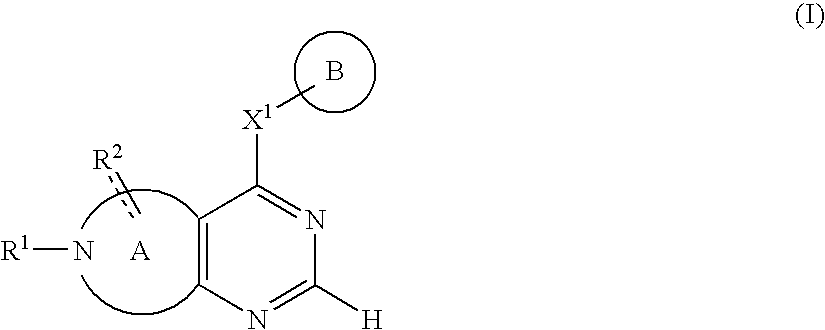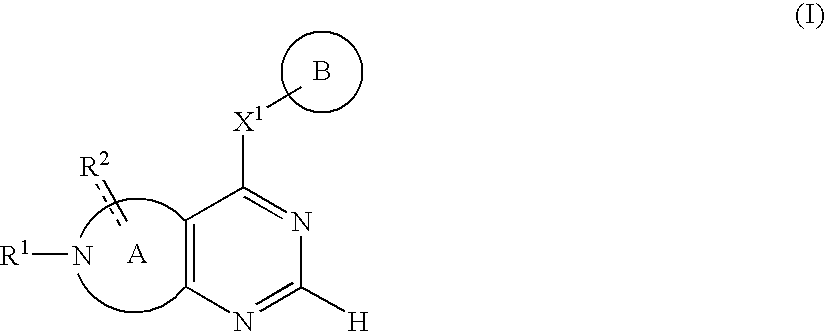Fused nitrogen-comprising heterocyclic compound
a heterocyclic compound and nitrogen-compound technology, applied in heterocyclic compound active ingredients, drug compositions, biocides, etc., can solve the problems of poor prognostic factor, poor simultaneous expression of each of these receptors, poor expression of receptors, etc., to achieve superior tyrosine kinase inhibitory action, high safety, and sufficient effect as a pharmaceutical produ
- Summary
- Abstract
- Description
- Claims
- Application Information
AI Technical Summary
Benefits of technology
Problems solved by technology
Method used
Image
Examples
reference example 1
Production of methyl 4-[(4-methoxybenzyl)amino]butanoate hydrochloride
[0698]Under hydrogen atmosphere, a mixture of 4-aminobutanoic acid (20.6 g), 4-methoxybenzaldehyde (29.9 g), 10% palladium-carbon (4.0 g), ethanol (300 mL) and 1N aqueous sodium hydroxide (200 mL) was stirred at room temperature for 7 days. Palladium-carbon was removed by filtration, and ethanol was evaporated under reduced pressure. Tetrahydrofuran (200 mL) was added to the residue, and di-tert-butyl dicarbonate (43 g) was added thereto dropwise at room temperature. The mixture was stirred at room temperature for 3 hr and extracted with hexane. The aqueous layer was acidified using 1N hydrochloric acid and extracted with diethyl ether. The organic layer was washed with saturated brine, dried over anhydrous magnesium sulfate and concentrated under reduced pressure to give 4-[(tert-butoxycarbonyl)(4-methoxybenzyl)amino]butanoic acid (62.7 g) as an orange oil. To a solution of 4-[(tert-butoxycarbonyl)(4-methoxybenzy...
reference example 2
Production of tert-butyl 4-[(4-methoxybenzyl)amino]butanoate
[0700]The mixture of tert-butyl 4-bromobutanoate (5.0 g) and 4-methoxybenzylamine (8.8 mL) was stirred at room temperature for 5 days. Aqueous sodium bicarbonate solution was added to the reaction mixture, and the mixture was extracted with ethyl acetate. The organic layer was washed with saturated brine, dried over anhydrous magnesium sulfate and concentrated under reduced pressure. The residue was separated and purified by column chromatography (hexane:ethyl acetate=3:1→2:1→1:1→ethyl acetate→ethyl acetate:methanol=19:1) to give the title compound (4.55 g) as a colorless oil.
[0701]1H-NMR (CDCl3) δ: 1.43 (9H, s), 1.74-1.83 (2H, m), 2.27 (2H, t, J=7.4 Hz), 2.63 (2H, t, J=7.1 Hz), 3.72 (2H, s), 3.80 (3H, s), 6.86 (2H, d, J=8.6 Hz), 7.23 (2H, d, J=8.6 Hz).
reference example 3
Production of methyl 5-[(4-methoxybenzyl)amino]pentanoate hydrochloride
[0702]Using 4-aminopentanoic acid (5.0 g), 4-methoxybenzaldehyde (6.39 g), 10% palladium-carbon (1.0 g), methanol (65 mL), 1N aqueous sodium hydroxide solution (43 ml), tetrahydrofuran (100 mL), di-tert-butyl dicarbonate (9.32 g), thionyl chloride (10.5 mL) and methanol (120 mL), a similar reaction as in Reference Example 1 was carried out to give the title compound (11.0 g) as colorless crystals.
[0703]1H-NMR (DMSO-d6) δ: 1.47-1.70 (4H, m), 2.34 (2H, t, J=6.9 Hz), 2.80-2.91 (2H, m), 3.59 (3H, s), 3.77 (3H, s), 4.04 (2H, s), 6.99 (2H, d, J=8.7 Hz), 7.44 (2H, d, J=8.7 Hz), 8.92 (2H, br s).
PUM
| Property | Measurement | Unit |
|---|---|---|
| temperature | aaaaa | aaaaa |
| temperature | aaaaa | aaaaa |
| reaction time | aaaaa | aaaaa |
Abstract
Description
Claims
Application Information
 Login to View More
Login to View More - R&D
- Intellectual Property
- Life Sciences
- Materials
- Tech Scout
- Unparalleled Data Quality
- Higher Quality Content
- 60% Fewer Hallucinations
Browse by: Latest US Patents, China's latest patents, Technical Efficacy Thesaurus, Application Domain, Technology Topic, Popular Technical Reports.
© 2025 PatSnap. All rights reserved.Legal|Privacy policy|Modern Slavery Act Transparency Statement|Sitemap|About US| Contact US: help@patsnap.com



